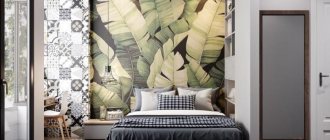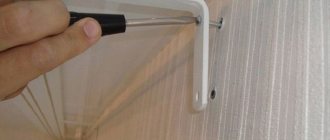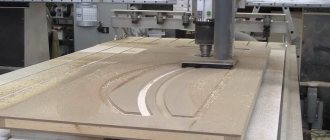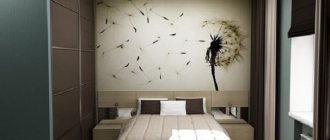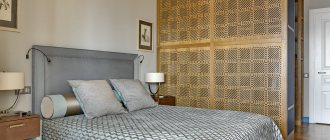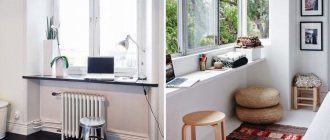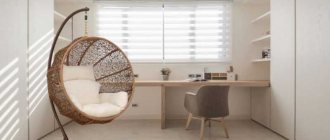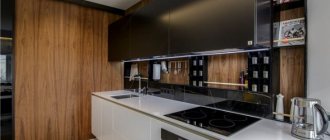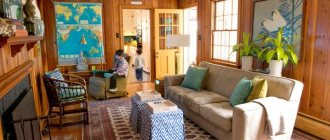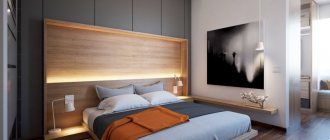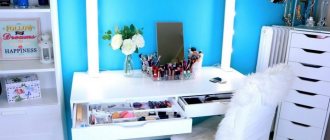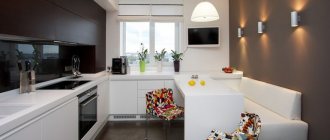Among the many different finishing options, soft wall panels stand out for their sophistication and originality. This decorative design is not often found. But it fits perfectly into any room interior. In this way, you can easily draw attention to certain areas of the room and emphasize your own style and individuality. Wall panels allow you to get away from banal, common solutions: painting and wallpapering. They add uniqueness to the atmosphere of the home. You can make the product yourself, which is a definite plus.
Materials used
A bedroom with soft wall panels looks unusual and modern; these details create an individual interior and also perform many functions, such as soundproofing the room and providing additional heat retention. Soft wall panels for the bedroom can be made from various materials, including:
- Soft leather panels for walls; in this case, genuine leather is used, which is used to cover the textured base. The use of such material adds luxury to the interiors and creates massiveness of the entire structure, giving the bedroom an exclusive appearance. But genuine leather is very expensive, so not many can afford the installation of soft panels made from such material. Despite this factor, leather soft wall panels are often used as a headboard for a bed or as an extension of this element;
- Wall panels made of artificial leather. A high-quality material that is suitable for those who want to save money, since its cost is slightly lower than a natural element, and its appearance is practically no different from the natural one. In addition, such a surface is much easier to clean and does not require special operating conditions;
- Textile upholstery of panels on the bedroom wall is the most common finishing option; the cost of the fabric is much lower than leatherette, but thanks to the many variations of texture and color, its use makes it possible to create any form of design, as well as give a luxurious look to the room for relatively little money.
The listed upholstery options for a soft panel are the main elements; in addition to them, there are other materials, for example, satin fabric, synthetics or plastic polymer films. These materials are rarely used for decoration, since they are not natural and are not suitable for finishing residential premises.
In addition to the upholstery fabrics mentioned above, the soft wall panels used to decorate a bedroom in an apartment will need several more elements, including:
- The base, which can be any flat platform, is most often used thick-walled plywood or chipboard. Such materials are quite hard and strong, and are also able to support the weight of the entire structure. In addition, if wood parts are used, this makes it easier to install the panel on the wall, since there is no need to drill additional holes for mounting screws;
- A soft layer between plywood and finishing fabric. This material can be used as medium-thick foam rubber or synthetic padding mats. Each of the fillers has its own pros and cons: for example, when using foam rubber, the surface will be more textured, thicker and softer, but making such a panel is much more difficult than with padding polyester. The latter is more suitable for beginners in this business, since there is less chance of making design errors.
Also, for the production of soft panels intended for wall decoration, you will need tie strips of fabric or wide buttons, which, when fixed to the base through the covering material, form a pattern and relief, depending on the requirements of the design project. It is these details that play the role of barriers and give the necessary texture.
Material for MDF panels
One way or another, everyone has come across MDF panels more than once because it was often used in the decoration of vestibules, carriages, office and other public premises.
For any room with pattern or texture
In residential buildings and apartments, their use was limited to finishing hallways and loggias. The design of MDF panels was not very diverse and therefore this material was considered a budget option for an official, restrained style.
Budget option for a room
Now MDF products are used for wall cladding, which are sometimes difficult to attribute to this material. They differ not only in their quality, but also in their varied appearance.
Light-colored panels
But let's first look at what these products actually represent. MDF wall panels are a decorative finishing coating of wood origin, made from waste wood, crushed to a dust fraction, with the addition of organic binding elements.
Decorative finishing material of wood origin
That is why the abbreviation MDF stands for “fine fraction”. During the manufacturing process, raw materials are subjected not only to pressure, but also to high temperatures, as a result of which the processed product in the form of panels is obtained with a dense, homogeneous structure.
Used for furniture and finishing materials
Such products are superior even to natural wood in terms of the possibilities for further processing during installation and are not inferior to it in terms of technological and environmental requirements. Installation of the panels is carried out either by fixing them to a frame made of wood or galvanized profile, or by gluing them to the wall surface with “liquid nails”.
Decorative finishing coating of wood origin
Advantages of soft wall panels
Soft panels used in the design of walls in the bedroom have a number of advantages. First of all, this is a non-standard solution for renovation and decoration, this type of decoration is found mainly in the homes of very wealthy people, but ordinary homeowners, if desired, can install a soft panel at the head of a sleeping bed; it will not cost very much.
After installing such an element and decorating the rest of the room, the appearance of luxury and prosperity is created, and the problem of finishing and leveling the walls is also solved.
Another advantage is the wide selection of upholstery to suit every taste and budget: depending on the design task, you can use fabrics and materials with any pattern, texture and shape. The soft panel is pleasant to the touch and can be used both as upholstery on the wall above the bed in the bedroom and as a headboard for the bed.
A velor piece with different piles is widely used as an extension of the head of the bed and can have any shape or be a multi-level surface.
Easy installation and low requirements for the base - installation of soft panels does not require special preparation of the wall; it is enough to plaster and putty it in a rough version, since the part itself will be part of the wall.
Expert opinion
Mikhailova Maria Vasilievna
Furniture store manager. Knows everything about comfort and interior design
Ease of operation - this part can be cleaned with chemicals or simply with a damp cloth, and the upholstery made of leather or leatherette also repels dust from its texture.
Fabric wall panels used for wall cladding in the bedroom can be used as a protective screen for communications laid on top of the base plane. To do this, you can install these parts directly on the wall or build a frame for fastening from a metal profile or wooden beam.
Also, an important advantage of this product is the ability to manufacture it yourself and exactly as required by the design project of the entire apartment. You can carry out all the drawings and markings yourself, having first studied all the necessary information and prepared a plan for the production of the structure.
Framed wall cladding
This method is based on the installation of a wooden slatted frame, between the slats of which filler is placed, and leather or fabric is stretched on top.
Important! The fabric is cut with allowances of 50 to 100 mm on each side. It is not recommended to choose a material with lines or large patterns: during the installation process, image elements may shift, which will negatively affect the overall appearance of the finish.
Fastening the upholstery begins from the top, having previously made 2-3 folds. This will avoid tearing the fabric. The work is carried out using a furniture stapler. You should monitor the tension so that folds and sagging do not form in the future.
USEFUL INFORMATION: Design options for a stylish bathroom: high-tech, modern, Scandinavian, marine
Tip: to simplify the process, a strip is attached to the lower edge of the fabric along the entire length, which under its weight will give natural tension in the vertical direction.
After this, the sidewalls are fixed. The bottom part is attached last. To achieve an original decorative effect, additional tightening elements can be used: slats, furniture buttons, etc. Doing this method yourself will require precise adherence to the technology, but the effect of the work is worth it.
Product Specifications
In the factory production of soft wall panels for bedroom decor, standard construction dimensions are most often used, which correspond to the dimensions of the plywood sheet, but if necessary, factories can produce these parts according to individual sketches. The thickness of the classic panel does not exceed 3 centimeters, this is the height of the foam filling.
When using padding polyester, the thickness of the resulting surface will be no more than 1.5 centimeters.
Assembling a panel from fragments
The panel can be prefabricated, that is, consist of small fragments attached to a common sheet of plywood or chipboard, or be a single whole, assembled directly on the base.
If the soft panel is made independently, it can be of any size and thickness, in accordance with the width of the headboard or the entire wall. You can also assemble a structure from several fragments of different colors or surfaces.
Installation features
To fix the soft panel on the wall in the bedroom, any fastening bolts or screws can be used, depending on the type of base material. If this is brickwork, then holes are first made into which spacer pads are driven; they will securely hold the dowel inside the cavity.
Fastening to a wooden base is much simpler; there is no need to install a spacer, but simply screw a sheet of plywood with panels right through to the wall. Places for screw heads should be chosen in invisible places, for example, in the corners of the part, slightly tilting the fabric upholstery.
Also, some experts suggest gluing these elements to the base using PVA. This method is rarely used, since it requires a flat wall surface and additional processing.
Thus, regardless of the complexity of the bedroom design project, soft wall panels are excellent for decoration, will decorate any interior and will give unusualness and individuality to the entire room.
No. 5. Size and forming method
The sizes of soft wall panels vary widely. These can be small soft tiles measuring 10*10 cm and huge panels 1.5*2.7 m. The shape is usually a square, rhombus or rectangle. Sometimes large panels that occupy the entire wall are replaced by installing two slats at the bottom and top, the space between which is filled with synthetic padding, and then a fabric sheet is pulled over the structure, but this option does not quite fit the description of soft wall panels.
If small elements, as a rule, are made smooth, then large panels are often made using capitonne, or carriage screed . Its essence is to embed large decorative buttons in the material in a certain sequence. Such decorations are often used in the manufacture of furniture, and previously they were used to decorate aristocratic interiors.
Buttons are usually staggered, forming squares or diamonds. In addition, buttons can be used to form an entire design (company logo, family coat of arms, etc.), thereby giving an interesting look to the room. The carriage screed looks better on plain materials, especially on leather, velor, velvet, suede, and artificial leather. Capitonnes are often used for small panels, whose main advantage is the ease of replacing damaged elements.
The size of soft wall panels is selected depending on your own design ideas and room parameters. If to decorate an entire wall in a room it will be more convenient to work with large panels, then to decorate only a small area it will be more appropriate to use small panels. By the way, the elements can be of completely different shapes, assembled on the wall like a kind of puzzle.
Although the soft wall panels themselves are voluminous, the so-called 3D panels stand out separately. They are made on the basis of MDF panels, gypsum or solid wood, which are given a certain shape, and then they are either painted or covered with leather or textiles. The latter option is often classified as soft wall panels, but due to the absence of a layer of synthetic padding polyester or foam rubber, they cannot be considered as such.
How to make wall panels with your own hands
Soft bedroom walls
Among the many different finishing options, soft wall panels stand out for their sophistication and originality. This decorative design is not often found.
But it fits perfectly into any room interior. In this way, you can easily draw attention to certain areas of the room and emphasize your own style and individuality.
Expert opinion
Mikhailova Maria Vasilievna
Furniture store manager. Knows everything about comfort and interior design
Wall panels allow you to get away from banal, common solutions: painting and wallpapering. They add uniqueness to the atmosphere of the home.
You can make the product yourself, which is a definite plus.
Panel structure
Due to their volume, soft wall panels for bedrooms and other rooms are also called 3D coating. In industrial conditions they are made using simple technology. You can reproduce the entire creation process yourself and create panels for the wall at home.
The layer-by-layer design of products is generally shown below in the table, but the constituent materials may differ for different models.
| Layer No. | Functions | How to create |
| 1 | substrate (base) | made from durable sheet materials with a thickness of 5 to 8 mm that have good adhesion to glue, for example, polyvinyl chloride |
| 2 | filling | secured to the base with synthetic winterizer or foam rubber, or liquid polyurethane foam (in the factory) |
| 3 | decorative finishing | cover the filler with leather or its substitute, or with fabric, securing the edges of the pieces to the backing |
Factory-produced models can also be coated with acrylic compounds (a millimeter layer) or vinyl with further heat shrinkage.
Sintepon as a filler is suitable for the bedroom, both for decorating the walls completely and for decorating the head of the bed. It weighs little, so the coating does not deform. It is laid on the substrate in strips, secured with nails or staples (using a stapler).
Room decorated with soft covering
Foam rubber is used in the manufacture of more voluminous wall panels. Such structures are stable, so they are used in gyms and children's rooms.
New or well-maintained soft wall coverings look great.
Manufacturing companies use special industrial equipment and expensive materials in production, which leads to the high cost of the final product.
Types of products
Panels for interior decoration are made in different shapes: square, rectangular, diamond-shaped. Their dimensions range from small (100x100 mm) to large (for example, 1.5x2.7 m). Finishing products are produced in the form of prefabricated structures consisting of individual tiles or entire sheets of material.
There are soft coverings with or without screed. The latter option is created on a solid base made of plywood (hardboard). It is stuffed with foam rubber (sintepon) and decorated. A wide variety of sizes of such products allows you to create unique, original designs with their help.
Large panels are often made using a carriage tie ("Capitone"). The meaning of this method is to embed special buttons into the material.
Using various combinations of their location, they create different types of relief on the surface of the coating. The method is used on velvet, leather, velor, suede finishing materials, as well as leatherette.
"Capitone" can also be used on small soft panels.
Products are mainly classified according to:
According to the first point, the following types of slabs are distinguished:
- covered with genuine leather;
- trimmed with leatherette;
- covered with fabric.
An eye-catching leather-covered panel option
As for the filler, products are usually filled with foam rubber or synthetic foam.
Each decorative finishing material and filler is characterized by certain properties. This creates differences in application areas.
Recommendations for selection
In order for soft walls to look good and harmonious in your home interior, you need to wisely choose finished products or select materials for self-production. Creating wall panels and then installing them with your own hands significantly reduces the cost of finishing your home.
When choosing, the general style of room design and the properties of the materials from which the products are made are taken into account.
When purchasing factory products, or preparing to manufacture them yourself, you should consider the following recommendations:
- if fabric panels are chosen, the covering must be durable and wear-resistant;
- the textile fabric should not fade over time, stretch, or sag;
- high-quality leatherette is a durable, practical, heavy material that is easy to care for and is not afraid of wet cleaning;
- leather is an expensive option, rarely used for DIY finishing, and it is also difficult for beginners to work with;
- when you need to create a thick layer of soft coating, it is better to use foam rubber for this purpose.
Following simple tips allows you to get a high-quality decorative coating; the photo below serves as an example of this.
Harmonious interior “insert”
The best upholstery option is furniture fabrics. Decorating walls with your own hands using them is easier to do than with other materials. Leather is often used to cover small slabs that are combined into a continuous panel. It is advisable for beginners to work with padding polyester, because it levels the surface and creates a relief pattern.
Pros and cons of coverage
Wall panels, due to their relief and the ability to form patterns, are used in interiors decorated in different styles (for example, baroque, high-tech). This makes it possible to decorate both private apartments and houses, as well as public institutions, offices, offices and other premises. Soft wall panels have the following advantages:
- good heat and sound insulation properties;
- beautiful, sophisticated (and often luxurious) appearance;
- the ability to divide a room into separate functional areas - zoning;
- they help to focus attention on interior details;
- ease of installation;
- hiding defects in wall surfaces;
- Products covered with artificial or natural leather are easy to care for.
Comfortable children's room
Successful zoning using soft panels, shown in the photo above, creates a special coziness in the nursery.
In addition to the advantages, the following disadvantages can be identified:
- high price for finished products, especially those produced to order;
- Fabric and suede surfaces require careful care because they can quickly lose their original appearance.
Wall panels, in addition to their decorative functions, allow you to mask surface imperfections and maintain warmth and tranquility in your home. Their distribution is limited mainly by the high cost and ignorance of the majority about this method of finishing.
DIY instructions
Branded products have a high price, and made to order are even more expensive. Making soft wall panels with your own hands will cost much less. To do this, you will need ordinary carpentry tools (for working with furniture) and materials:
- ruler, tape measure, pencil;
- scissors, knife;
- stapler;
- drill with a set of drills (you can use a screwdriver);
- nylon cord;
- plywood;
- buttons;
- hook;
- hand saw or jigsaw
One of the possible options for making soft walls at home comes down to the following steps:
- fragments of the required size are cut out of a sheet of plywood (3-5 mm thick), which will be the substrate of the product being created;
- on the prepared base, markings are made for buttons and fastenings to the wall;
- drill holes according to the marks;
- fragments of the same size as the substrate are cut from padding polyester or foam rubber;
- fix them with glue on plywood;
- The prepared finishing material is cut according to the size of the substrate with an allowance of about 7 cm, taking into account the thickness of the base and filler, folded to the back side of the fragment;
- thread a nylon cord through the holes of the buttons;
- they are covered with a decorative covering;
- use a hook to hook the cord and pull it to the back side, recessing the button in the outer finishing coating and filling;
- the extended end is secured with staples using a stapler;
- fasten the remaining buttons crosswise (fixing the last one in the center) to avoid possible distortions of the front layer of the panel;
- wrap the allowance of finishing material onto the back side of the plywood and secure it with staples.
Before covering with decorative material, you should end up with a blank similar to the one shown in the photo below.
A small panel is even easier. To do this, perform the following operations:
- cut out the backing from plywood or fiberboard;
- cut the facing material, secure one edge of it from the wrong side;
- cut out the filler and fix it on the base;
- Evenly stretching the free edges of the outer covering, secure them with staples to the base.
There are many more different options for making soft panels. Here a lot depends on personal skills, knowledge, and imagination. The choice of plywood thickness depends on the dimensions of the final structure: 5 mm sheets are used for large products, and 3 mm for small ones. Furniture stores sell ready-made buttons covered with material.
Installation technology
Soft walls, made by hand or purchased ready-made, are fixed to the wall in different ways.
One option is to install the panels on a frame. The work is performed in the following sequence:
- install a cellular frame made of wooden slats, securing it with dowels on the wall;
- fill the cells with foam rubber, gluing it to the base;
- cover the structure with padding polyester, securing it along the edges with a stapler;
- stretch the skin, fixing it on the slats around the perimeter;
- mask the attachment points by gluing decorative tape;
- Cover furniture nails with finishing material and hammer them into the laths.
When driving nails, in order not to damage the upholstery, use synthetic pads.
You can simply glue the panels if the condition of the base allows. Here's how it works:
- mark the working area on the wall surface;
- apply the adhesive to the back side of the panel;
- press the fragment against the wall according to the markings, starting pasting from bottom to top, or vice versa;
- in this way all elements of the coating are fixed;
- if the side fragments extend beyond the working area, then they are cut off with a hacksaw, having first disassembled the panel (after which it is put back together).
Applying glue to the back of the panel
PVA and liquid nails are often used as adhesives. The first is applied in a continuous layer to the substrate, and the second - in a zigzag or dots. Small parts are even secured with double-sided tape.
When gluing, you should be careful not to get the composition on the front side. If this happens, you should immediately wipe off the glue with a damp cloth.
When decorating walls with soft panels, large-sized products are often mounted by hanging them on special elements for fastening. Self-adhesive types of bases and magnets are also available. The choice of installation method depends on the condition of the wall surfaces, financial capabilities and personal skills.
Finished products are not cheap. But there are various ways to make a soft wall with your own hands. This significantly reduces the cost of the entire process: from creation to installation. The constituent materials are widely available and affordable.
Wall panels are a finishing method that has a beautiful appearance. At the same time, the level of extraneous noise in the room is further reduced, its thermal insulation is improved, and the living space is divided into sections as needed.
The types of soft panels are described in the following video.
The process of making products with your own hands and fixing them on the wall is shown in the video below.
Panel structure
Due to their volume, soft wall panels for bedrooms and other rooms are also called 3D coating. In industrial conditions they are made using simple technology. You can reproduce the entire creation process yourself and create panels for the wall at home.
The layer-by-layer design of products is generally shown below in the table, but the constituent materials may differ for different models.
| Layer No. | Functions | How to create |
| 1 | substrate (base) | made from durable sheet materials with a thickness of 5 to 8 mm that have good adhesion to glue, for example, polyvinyl chloride |
| 2 | filling | secured to the base with synthetic winterizer or foam rubber, or liquid polyurethane foam (in the factory) |
| 3 | decorative finishing | cover the filler with leather or its substitute, or with fabric, securing the edges of the pieces to the backing |
Factory-produced models can also be coated with acrylic compounds (a millimeter layer) or vinyl with further heat shrinkage.
Sintepon as a filler is suitable for the bedroom, both for decorating the walls completely and for decorating the head of the bed. It weighs little, so the coating does not deform. It is laid on the substrate in strips, secured with nails or staples (using a stapler).
Room decorated with soft covering
Foam rubber is used in the manufacture of more voluminous wall panels. Such structures are stable, so they are used in gyms and children's rooms.
New or well-maintained soft wall coverings look great.
Manufacturing companies use special industrial equipment and expensive materials in production, which leads to the high cost of the final product.
Are soft panels relevant for wall decoration?
Soft wall panels can complement the design of the room and create warmth and comfort inside. In addition, the material looks noble, luxurious and rich. Vintage and classic designs are becoming more and more popular.
The products not only look beautiful, but are also a good functional solution. This is especially true for those who have small children. During the first years they begin to learn to walk and explore the world. Thanks to the soft finish, the child will be protected from bruises and damage. Another plus is excellent sound insulation properties.
As for design tricks, they are:
- In the bedroom, calm, pastel colors will be relevant. The color will not be annoying and will help create a gentle atmosphere, comfortable for sleeping.
- For the kitchen, soft decorative panels are rarely used due to impracticality. As an option, decorate only the bar and corners of the room with them.
- The living room can be decorated in any color, based on the overall design of the house.
- But for a children's room you can choose bright colors.
The advantage of finishing with soft panels is that they are perfectly combined with other finishing materials, so everyone can create an original and unique interior.
Recommendations for selection
To ensure that soft panels are not purchased in vain, it is important to follow these tips from designers:
- It is better to buy panels made of padding polyester for the bedroom. They are lightweight and do not load the structure. A good option is to decorate a certain area in the bedroom with them, for example, the area above the head of the bed. As for the choice of color, you need to build on the shades of curtains or wallpaper. Sometimes it makes sense to play with contrast. It is better to choose calm shades.
- For the living room and children's room, it is better to choose more durable options made of foam rubber and polyurethane. They will withstand the negative impact and will look beautiful. If we compare them with padding polyester panels, they are somewhat larger.
- Wall panels in the interior of a children's room should be primarily functional. Namely, from foam rubber, since they are voluminous and softer.
- As for the living room and hallway, it is advantageous to use a leather surface or leatherette. As an option, suede or velvet. The main requirement for soft finishing in such rooms is increased wear resistance. And if there is antibacterial impregnation, then this is simply ideal.
In this matter, it is better not to save money and buy quality products. Or you can make soft panels for the walls with your own hands. This will reduce the cost, however, it will require more time and effort. But it's worth it.
Interiors with soft panels for walls, 20 photos
There are many finishing materials for walls. The assortment of stores has become so large that deciding on the choice of material becomes a difficult dilemma.
In this article we will talk about the choice of wall panels, which have recently become popular wall decorations. They are presented in a wide range of textures and colors, are easy to install (soft panels are quite easy to make with your own hands) and can be mounted on any surface.
We will talk about soft wall panels that are perfect for decorating houses, apartments and country houses. For example, in the bedroom they are used instead of the head of the bed. In the living room, they can be used to cover the wall next to the sofa, or to highlight an entertainment area. This technique will help create a cozy and warm environment.
Soft wall upholstery will highlight the elegance of the room
In addition to their external advantages, they are also good because they isolate sound. Almost all public institutions have long appreciated all the advantages of this finishing. In private interiors, various types of fabrics can be used as upholstery. Felt, natural or artificial leather are suitable for public institutions.
Soft panels in the bedroom
Expert opinion
Mikhailova Maria Vasilievna
Furniture store manager. Knows everything about comfort and interior design
In the bedroom, such panels are often used instead of a headboard. A small bedroom looks very cozy and intimate, in which a soft wall is combined with a soft headboard.
The soft panels will also look beautiful in the living room. They will have not only an aesthetic, but also a practical function. This is excellent protection for your walls from wear and tear. They are also easy to clean and wash, which is especially important for families with children.
Add luxury to your interior
If you are still doubtful about the benefits of such panels, take a look at the following interesting room design ideas with wall coverings. You can find something special for every room!
Soft decorative panels, presented in deep burgundy color
Home theater owners will love these panels. You will not only decorate your room, but also prevent noise from entering another room.
Interesting and unique solution for the bedroom
Try combining fabric and leather panels as shown in the photo above. This combination will look elegant and impressive.
Soft wall panels for the bedroom
Black soft panels are best used if the room is spacious and bright. This will help avoid a depressive atmosphere.
Use soft wall upholstery only as a bright highlight in the interior. Soft panels with fabric texture can be decorated with an exclusive image created by digital printing on fabric.
Luxurious living room with accent on soft wall panels
Corner wall panels perfectly emphasize the elegance of the room, provide sound insulation and eliminate echoes
Advantages and disadvantages of soft wall panels
When carrying out renovations in a residential area, the reliability and durability of the building materials used are taken into account. Decorating walls with soft panels has the following positive aspects:
- Good air and moisture permeability. With the help of such characteristics, optimal temperature and humidity are maintained in the room.
- Possibility to clean and wash walls.
- The use of soft wall panels will add gloss, luxury and individuality to the interior of the room.
- High resistance to mechanical loads of various types.
- Soft wall panels for the bedroom with a relief pattern can be used in any stylistic direction: baroque, high-tech, art deco and modern.
- Long-term use, high wear resistance. The service life of soft panels reaches up to a quarter of a century.
- Excellent noise and heat insulation properties.
- Safe for humans. When heated, they do not emit toxic substances and are not prone to fire.
- Large selection of colors and styles.
- Easy and quick installation. Does not require special skills or knowledge. Laying wall panels can be done even by an inexperienced craftsman.
- There is no need to pre-prepare the wall surface before installation.
- The ability to hide uneven walls and defects, as well as various wires and communications.
- While maintaining the appearance, the dismantled soft panels can be used repeatedly.
An important point is that the use of soft wall panels is intended for spacious rooms. In small rooms, when decorating walls, designers recommend using them on individual surfaces, bringing uniqueness and originality to the interior.
The disadvantages of such panels include the high price per unit of product. This is especially true for panels upholstered in genuine leather. The use of fabric materials is unacceptable in case of allergic reactions in humans to dust.
Free measurement + design project of the wall for you
We sell soft wall panels of any complexity
Why do we do a free design project for a wall with soft panels?
Often our clients don’t know what they want or doubt which panel model is best suited for their interior; we make several free sketches for a better understanding of the client. We also make drawings to correctly place sockets and integrate panels into the interior.
When our customers see a sketch, it is easier for them to visualize how and what material will look better.
Soft wall panels for the interior are a cozy and practical solution for the interior, we select the material and shape individually, our panels become a delicate accent and bring comfort and warmth to the house.
Get a free design project
The material we work with
More than 300 varieties of fabric
Our company works with various manufacturers of materials, from Russian manufacturers to exclusive fabrics made to order.
In some projects we use washable materials that can be cared for even with detergents; other projects require delicate and very gentle fabrics. We discuss all the details of selecting materials during a meeting and provide samples.
You can also see the most popular types of materials in the “Materials” section.
